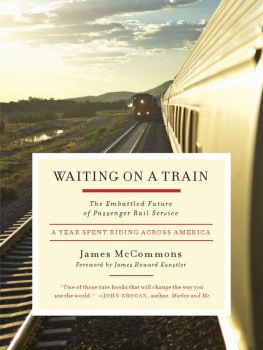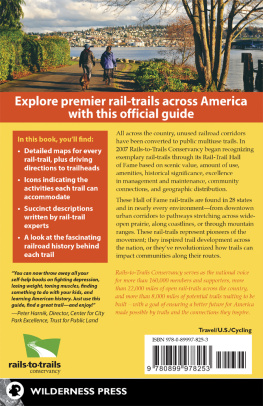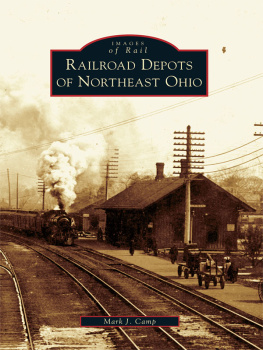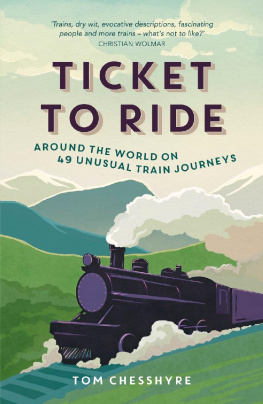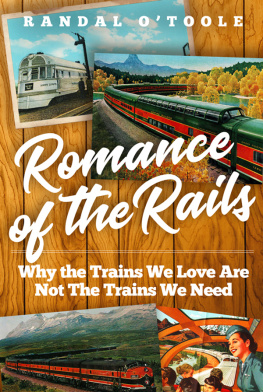WAITING ON A TRAIN
The Embattled Future
of Passenger Rail Service
James McCommons
Foreword by James Howard Kunstler
Chelsea Green Publishing Company
White River Junction, Vermont

Copyright 2009 by James McCommons.
All rights reserved.
Foreword copyright 2009 by James Howard Kunstler. All rights reserved.
No part of this book may be transmitted or reproduced in any form by any means without permission in writing from the publisher.
Project Manager: Emily Foote
Developmental Editor: Jonathan Cobb
Copy Editor: Cannon Labrie
Proofreader: Helen Walden
Indexer: Christy Stroud
Designer: Peter Holm,
Sterling Hill Productions
Printed in the United States of America
First printing October 2009
10 9 8 7 6 5 4 3 2 1 09 10 11 12 13 14
Our Commitment to Green Publishing
Chelsea Green sees publishing as a tool for cultural change and ecological stewardship. We strive to align our book manufacturing practices with our editorial mission and to reduce the impact of our business enterprise on the environment. We print our books and catalogs on chlorine-free recycled paper, using vegetable-based inks whenever possible. This book may cost slightly more because we use recycled paper, and we hope youll agree that its worth it. Chelsea Green is a member of the Green Press Initiative (www.greenpressinitiative.org), a nonprofit coalition of publishers, manufacturers, and authors working to protect the worlds endangered forests and conserve natural resources.
Waiting on a Train was printed on Natures Book Natural, a 30-percent postconsumer-waste recycled paper supplied by Thomson-Shore.
Library of Congress Cataloging-in-Publication Data
McCommons, James, 1957- Waiting on a train: the embattled future of passenger rail service / James McCommons; foreword by James Howard Kunstler.
p. cm.
eBook ISBN: 978-1-60358-259-9
1. Railroads--United States. 2. Transportation--United States. I. Title.
HE2741.M196 2009
385.220973--dc22
2009030142
Chelsea Green Publishing Company
Post Office Box 428
White River Junction,VT 05001
(802) 295-6300
www.chelseagreen.com
CONTENTS
Amtrak routes and corridors

The world economic fiasco, which I call The Long Emergency, may be speeding us into a future of permanent nostalgia in which anything that is not of the present time looks good. I say this to avert any accusations that I am trafficking in sentimentality where the subject of railroads is concerned. For the moment, any suggestion that a railroad revival in America might be a good thing is generally greeted as laughable for reasons ranging from the incompetence of Amtrak, to the sprawling layout of our suburbs, to our immense investment in cars, trucks, and highwaysmotoring culture now overshadowing all other aspects of our national identity.
This said, I will hazard to engage in a personal sentimental journey to the memory bank of my many adventures on trains, starting with the best: my yearly journey from New York City to summer camp in New Hampshire, which I repeated for several years beginning in 1959. Apart from my delirious joy at getting out of the city for two whole summer months, the trip itself was magical. The camp rented two Pullman sleeper cars. They smelled deliciously of machine oil and freshly washed linens, and were air-conditioned to arctic levels of temperature. Whatever wasnt luxuriously plush was polished to a high sheen, including a lot of chrome and brass.
We departed from Pennsylvania Station about 9:00 p.m. for the overnight trip. Most of us stayed awake until the wee hours terrorizing the porter with our water guns, visiting in each others berths (sharing troves of Zagnut bars, Raisinets, and sometimes even booze filched from our parents liquor cabinets), and watching the cavalcade of the New England landscape scroll through the window in the moonlight, past the tobacco-growing sheds of the Connecticut River valley, the ghostly switching yards, and the quiet streets of nameless small towns. Eventually, the rocking train lulled most of us to an hour of sleep.
We pulled into our destination, White River Junction, Vermont, near the crack of dawn, and then we bleary little insomniacs were stuffed into an old U.S. Armysurplus troop truck for the last leg of the journey across the river to New Hampshirethen a wonderfully backward corner of the country with no interstate highways and lots of men with beards. The reverse trip home at the end of August was fun, too, in the same way, except for our tragic fate of having to return to the rigors of school.
I rode the Long Island Railroad commuter line a lot in the 1960s because I lived in Manhattan with my mom and stepfather and was exported on Saturdays twice a month to visit my father in the suburbs. While it became routine, it was never dull watching the endless lumpenprole precincts of Queens County, with their unimaginably dreary asphalt-shingled shoebox houses, numberless auto scrapyards, and chaotic shopping boulevards of colorful folks from foreign lands. I often rode back Monday mornings with my father, along with a thousand other identical men in suits and hats. Up until 1963, the great old Pennsylvania Station still existed, and one rose out of the transportation bowels of the city, with those ranks of suited and hat-wearing executives, like a conquering legion through a set of triumphant vaults to the great global engine that was New York in the postwar decades.
Train service went straight to hell by the late sixties. In college, I took the old New York Central from Rochester to New York City a few times, but by then the rolling stock had developed the ambience of a lavatory, with trash everywhere, and the upholstery rotting, and odoriferous men snoring across the rows of seats. There were mysterious delays all along the way. The old Beaux Arts train stations in Syracuse and Albany had not yet been turned into banks, but you could no longer buy so much as a stick of gum in them. The inducement to drive, instead, on the brand-spanking-new New York State Thruway, was huge.
By the mid-1970s, American passenger rail, in near total disarray, fell under the baleful sway of Conrail and Amtrak, both apparently created on a Soviet-management model, with an extra overlay of Murphys Law to insure maximum entropy of service. In 1974 I took the San Francisco Zephyr from New York to Oakland, California. It was, of course, uncomfortable, filthy, and cold, with worn-out rolling stock, iffy linens, and onboard food consisting of mystery-meat sandwiches prepared solely in a Radar Range. The most remarkable thing about this journey was how we managed to avoid anything scenic. The initial run was overnight from New York to Chicago in the November darkness. In Chicago, we had such a long layoverall day, reallythat I was able to tour the Art Institute, the Field Museum, and even take in a movie before we resumed our journey on a different train. We rolled through Iowa and Nebraska all night and I woke up somewhere along the bleak prairie outside of Denver. In that city, we parked on a siding near a stockyard all day long for reasons never explained, and departed again at dusk for the leg through the Rockies. Things finally got interesting the next morning in Sparks, Nevada, when we entered the Sierras, but the Radar Range cuisine had introduced some malign flora into my guts and I spent most of that final leg in the bathroom.
Next page
